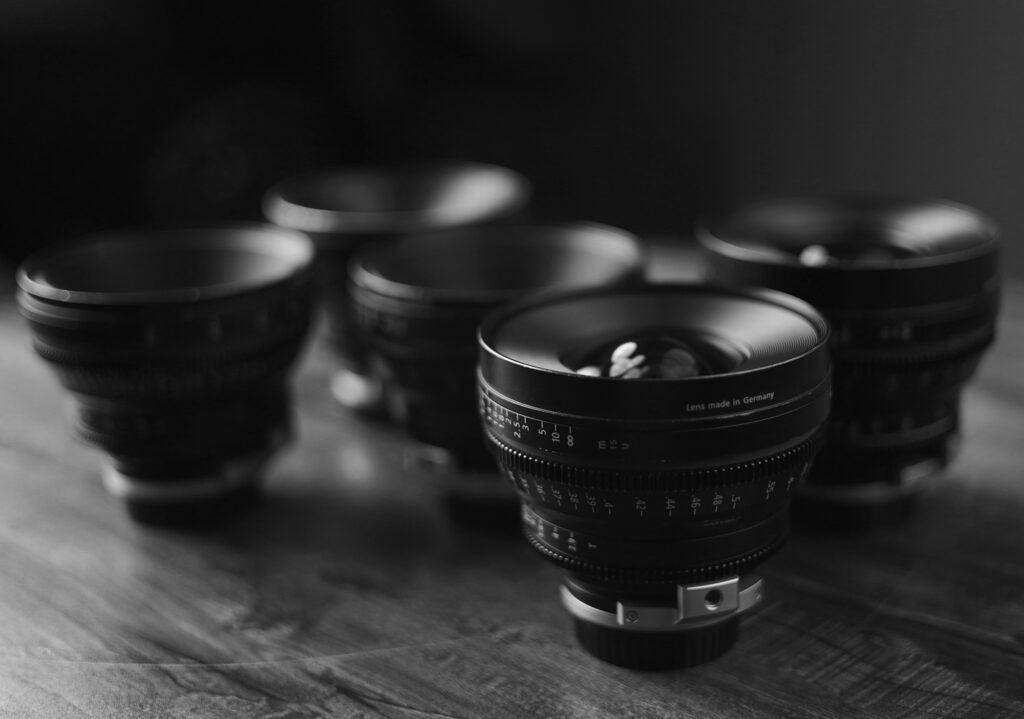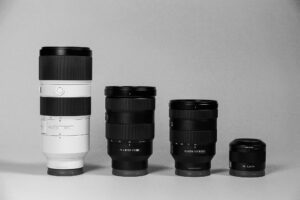If you’re serious about creating video content -for YouTube, client work, short films, or commercial projects- you’ve probably wondered whether cinema lenses are worth the investment. At first glance, they look similar to regular photography lenses, but there’s a lot happening under the surface. This guide breaks down the differences between cinema lenses and photography lenses, helping you understand which one makes the most sense for your workflow, gear budget, and creative goals.
If you’re not familiar with the technical jargon, read my lens terminology guide first.
TL;DR
- Cinema lenses offer smooth manual focus, de-clicked aperture, and zero focus breathing, great for professional filmmaking.
- Photography lenses can still work well for video, especially if they have silent autofocus and image stabilization.
- Cine lenses are often more expensive, larger, and heavier, but deliver consistent results across shots.
- Hybrid creators can get the best of both worlds with modern video-friendly photography lenses.
- For most beginners or solo creators, you don’t need a true cinema lens right away, invest when your workflow demands it.
This post is just one part of my “Lens Buying Guide“, which you can download as a pdf file right now.
1. What Is a Cinema Lens?
Cinema lenses (also called cine lenses) are specifically designed for video production. They’re not just about image quality. They’re built for precise, repeatable control in a film or video setting.
Key features of cinema lenses:
- True manual focus and aperture rings with hard stops
- Long focus throw for fine-tuned focus pulling
- Consistent T-stop ratings instead of F-stops (T-stops measure actual light transmission)
- De-clicked aperture for smooth exposure transitions
- Standard gear rings for use with follow focus and other rigging
- Minimal focus breathing (the image doesn’t zoom slightly when you change focus)
They’re also usually larger, heavier, and built to match across a lens set (same weight, size, focus ring placement, etc.)
2. How Photography Lenses Work for Video
Still photography lenses (which most of us use for video too) are optimized for speed, autofocus, and size: great for handheld or run-and-gun setups.
Photography lenses:
- Often have focus-by-wire systems (especially mirrorless)
- Focus throw is short, making manual focus harder
- Use F-stop ratings, which don’t account for light loss through the lens
- Usually don’t have gear rings, so rigging them takes adapters
- Some have strong focus breathing, which can be distracting in video
But they’re also:
- Much more affordable
- Smaller and lighter
- Easier to find and use across hybrid workflows (photo + video)
3. Do You Really Need a Cinema Lens for Video?
Short answer: not unless you really need one.
If you’re shooting:
- Commercial films
- Documentaries with a crew
- Music videos with planned focus pulls
- Studio interviews with full rig setups
… then cinema lenses might be a worthwhile investment.
But for:
- YouTube videos
- Social media content
- Travel or event work
- Run-and-gun documentaries
… a good photo lens with manual focus control is often more than enough.
4. Key Differences Between Cinema Lenses and Photography Lenses
| Feature | Cinema Lenses | Photography Lenses |
| Focus Control | Manual focus only, with long focus throw for smooth control | Autofocus + manual, shorter throw, quicker adjustments |
| Aperture Design | De-clicked aperture ring, smooth adjustments, uses T-stops | Clicked aperture ring, uses f-stops |
| Focus Breathing | Minimal or no focus breathing | Often visible, especially in budget lenses |
| Color Consistency | Matched across lens sets for uniform color and contrast | Can vary between different models |
| Build & Housing | Heavy-duty, built for rigs, consistent size for accessories | More compact and lightweight, sizes vary |
| Gearing | Built-in geared rings for focus, iris, and zoom | No standard gearing; not rig-friendly without adapters |
| Price | Expensive, designed for professional film production | Ranges from budget to premium, more affordable options available |
| Use Case | Ideal for controlled video shoots, especially narrative work | Best for stills, vlogs, hybrid shooting, and casual use |
5. Hybrid Lenses for Hybrid Creators
Some manufacturers now offer hybrid lenses: photo lenses with cinema-style features like manual aperture rings, reduced focus breathing, or built-in gear teeth. These are perfect for creators who do both stills and video but want a bit more control.
Look for terms like:
- “De-clicked aperture”
- “Cine-mod”
- “Video optimized” or “Linear manual focus”
Brands like Sigma, Samyang/Rokinon, Viltrox, and even Sony/Canon have started releasing hybrid-friendly models.
Reminder: This post is just one part of my “Lens Buying Guide“, which you can download as a pdf file right now.
Last Words
Cinema lenses are built for control, precision, and consistency. But that doesn’t mean they’re the right fit for every video creator. For most people starting out or shooting solo, a high-quality photo lens will do the job just fine. As your projects become more demanding, you may find the features of a cinema lens increasingly worth the investment. Until then, knowing the strengths and trade-offs of each option will help you build a video rig that works for you, not just one that looks impressive on paper.
FAQ
What’s the main difference between cinema lenses and photography lenses?
Cinema lenses are designed for smooth, precise focus and aperture control, while photography lenses are optimized for still images.
Are cinema lenses sharper than photography lenses?
Not necessarily. Cinema lenses prioritize consistency and manual control over extreme sharpness.
Can I use a photography lens for filmmaking?
Yes, many filmmakers use photography lenses, especially when starting out, but cinema lenses offer more control for professional work.




